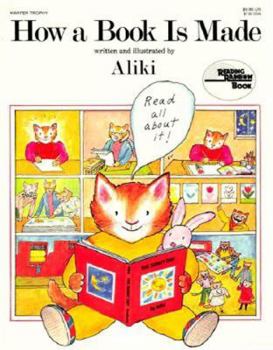How a Book Is Made
Select Format
Select Condition 
Book Overview
Who made this book? (We all did ) Author-Artist (Illustrator) Editor Publisher Designer Copyeditor-Proofreader Production Director Color Separator Printer Publicity and Promotion Director Salesperson
Format:Paperback
Language:English
ISBN:0064460851
ISBN13:9780064460859
Release Date:June 1988
Publisher:HarperCollins
Length:32 Pages
Weight:0.53 lbs.
Dimensions:0.1" x 7.9" x 10.0"
Age Range:4 to 8 years
Grade Range:Kindergarten to Grade 3
Customer Reviews
5 ratings
This book rocks the socks of adults, even!
Published by Thriftbooks.com User , 16 years ago
I've been interested in books and how they're created ever since I can remember. So, when I noticed this book I had to give it a look. And, I have to say, this book is a treat as well as informative. The author goes through every step of the process, but in a very entertaining way. The art is whimsical and fun, and there is even some humor thrown in into the mix as well. This book is great for both those looking into the book-making process AND searching for a good read. I'd even go so far as to recommending this book to people who hope to go into the writing industry as either an author/artist, publisher, editor, book designer, etc.! Two thumbs up!
I really want to know...
Published by Thriftbooks.com User , 16 years ago
Do you have any idea how a book is made? Or, how many people are involved? Or, how long it takes from the first idea to holding a finished product in hand? Aliki, that wonderful writer and illustrator, shows us in thirty-one 8 x 10 pages with the 32nd page showing young cat in bed with his new book beside him (that's young cat on the cover). "How A Book Is Made" is an impressive insider's view of the book-making process. On the title page is a young cat holding a book with all its parts labeled. As he reads a book in the library, he says things near and dear to a librarian's heart: "I like the way a book feels. I like the way a book smells" and wants to know who is responsible for this wonderful creation. There they are--the lines of people: author, illustrator, editor, publisher, designer, copy editor/proofreader, production director, color separator, printer, publicity and promotion director, and salesperson. Then Aliki starts with the author's idea, research, writing, editing, revising, and finally the manuscript is sent to her editor. (This is an established writer.) Then waiting and more waiting for decisions. Each person is introduced who has book-making responsibility, who shows us what he/she does. In between is more work for the writer. Finally the printing is done. I have a feeling that color separation is now handled by computers and not the tedious steps shown in the book, which, after all, is dated at 1988. No matter, "How a Book Is Made" still shows the grueling process of making a book. However, it is all worthwhile when that final product is put in hand. As the author and her child (young cat) celebrate the publication, the next phase of work begins: promotion and publicity. Meetings with book sales staff, television appearances, book signings, book reviews, placements in libraries and bookstores--it's all germaine to the publication of a book. And that's how a book is made. Who needs this book? Libraries, of course, creative writing classes, children who show a propensity to write, and visual learners. There is nothing like a picture book in clarifying things that could seem complicated in print. Highly recommended!
"Who Made This Book?"
Published by Thriftbooks.com User , 17 years ago
This book will appeal to a wide range of readers. Main text is written for younger readers and well-supported by Aliki's soft, colorful watercolor illustrations (populated by publishing cats!), and accompanied by humorous dialog. Older readers will appreciate the more detailed explanations of production that appear in smaller type and are framed within the illustrations. Additional attention to detail is evidenced in the fine points of Aliki's illustrations, such as the small calendar that appears on nearly every two-page spread and the occasional seasonal clues (e.g., a jack-o-lantern in the window) which provide a time frame to the observant reader. Dialog balloons offer a personal glimpse at the individuals who produce a book, and often provide insightful humor as well. (For example, the dialog from an editor's desk reads: "This pile gets bigger and bigger.") As book production moves from initial creation (crafting text and pictures, editing, etc.) to production, Aliki's illustrations become necessarily somewhat more complex: one two-page spread clearly shows the four-color offset printing process, including a detailed cross-section of the inside of the printer. However, the youngest readers are always in mind, and the book never leaves them behind. Published in 1986, the technology mentioned (floppy disks and magnetic tape; even the printing process) is somewhat dated, but aside from that, this outstanding book offers a great look at the many steps and people that it takes to make a book.
An inspiring and fascinating book
Published by Thriftbooks.com User , 19 years ago
I read this book in the 2nd grade, when it was first published. This book made me want to be a writer. Aside from being completely informative, the illustrations are beautiful. I still own my original copy, and writing is my biggest passion and greatest reward in life. Every child and adult should get their paws on this book and I hope it will always continue to inspire all of our future writers of the world.
Informative
Published by Thriftbooks.com User , 24 years ago
Informative and accurate even with changing technology. If you want to teach your children the step by step process of how a book is made, Aliki clearly demonstrates this with her illustrations and text. Great author!! I recommend all her books.





